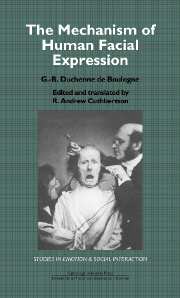Book contents
- Frontmatter
- Contents
- Acknowledgments
- Contributors
- Editor's Preface
- Part 1 The mechanism of human facial expression or an electrophysiological analysis of the expression of the emotions
- Preface
- A Introduction
- B Scientific section
- Foreword
- Chapter 5 Anatomical preparations, and portraits of the subjects who underwent electrophysiological experiments
- Chapter 6 The muscle of attention (m. frontalis)
- Chapter 7 The muscle of reflection (superior part of m. orbicularis oculi, that part of the muscle called the sphincter of the eyelids)
- Chapter 8 The muscle of aggression (m. procerus)
- Chapter 9 The muscle of pain (m. corrugator supercilii)
- Chapter 10 The muscles of joy and benevolence (m. zygomaticus major and the inferior part of m. orbicularis oculi)
- Chapter 11 The muscle of lasciviousness (transverse part of m. nasalis)
- Chapter 12 The muscle of sadness (m. depressor anguli oris)
- Chapter 13 The muscles of weeping and whimpering (m. zygomaticus minor and m. levator labii superioris)
- Chapter 14 The muscles complementary to surprise (muscles that lower the mandible)
- Chapter 15 The muscle of fright, of terror (m. platysma)
- Chapter 16 A critical study of several antiquities from the point of view of m. corrugator supercilii and m. frontalis
- C Aesthetic section
- Part 2 Commentary chapters
- Index
Chapter 14 - The muscles complementary to surprise (muscles that lower the mandible)
Published online by Cambridge University Press: 10 November 2010
- Frontmatter
- Contents
- Acknowledgments
- Contributors
- Editor's Preface
- Part 1 The mechanism of human facial expression or an electrophysiological analysis of the expression of the emotions
- Preface
- A Introduction
- B Scientific section
- Foreword
- Chapter 5 Anatomical preparations, and portraits of the subjects who underwent electrophysiological experiments
- Chapter 6 The muscle of attention (m. frontalis)
- Chapter 7 The muscle of reflection (superior part of m. orbicularis oculi, that part of the muscle called the sphincter of the eyelids)
- Chapter 8 The muscle of aggression (m. procerus)
- Chapter 9 The muscle of pain (m. corrugator supercilii)
- Chapter 10 The muscles of joy and benevolence (m. zygomaticus major and the inferior part of m. orbicularis oculi)
- Chapter 11 The muscle of lasciviousness (transverse part of m. nasalis)
- Chapter 12 The muscle of sadness (m. depressor anguli oris)
- Chapter 13 The muscles of weeping and whimpering (m. zygomaticus minor and m. levator labii superioris)
- Chapter 14 The muscles complementary to surprise (muscles that lower the mandible)
- Chapter 15 The muscle of fright, of terror (m. platysma)
- Chapter 16 A critical study of several antiquities from the point of view of m. corrugator supercilii and m. frontalis
- C Aesthetic section
- Part 2 Commentary chapters
- Index
Summary
Plates 54, 55, 56, 57
Plate 54: To study the lines, the skin folds, and other changes produced by the muscles that lower the mandible, in an old man (also shown in Plates 3, 7, 8, 9, 12, 13, 14, 17, 18, 19, 20, 21, 22, 30, 31, 32, 33, 34, 37, 38, 39, 43, 44, 45, 46, 47, 48, 49, 51, 52, 53).
Voluntary lowering of the lower jaw with the skin of the lower part of the face; inexpressive movement.
Plate 55: To show that it is not sufficient to open the mouth and elevate the eyebrows to portray astonishment. These movements may just produce a grimace, unless there is a perfect rapport between them.
Maximal voluntary opening of the mouth, with voluntary, mild elevation of the eyebrows: astonishment badly rendered by the subject: a ridiculous and inane expression.
Plate 56: To study combined moderate contractions of m. frontalis and of the muscles that lower the mandible. Voluntary, moderate opening of the mouth and proportional electrical stimulation of mm. frontalis: surprise.
Plate 57: To study the combined maximal contraction of mm. frontalis and the muscles that lower the mandible. Voluntary maximal opening of the mouth and energetic electrical stimulation of mm. frontalis: astonishment, stupefaction, amazement.
Further notes on these plates
Technical details
The muscles that lower the mandible and their motor nerves are covered by m. platysma and cannot be electrized without this latter muscle contracting at the same time; their independent excitation is only possible when m. platysma is atrophied or no longer excitable.
- Type
- Chapter
- Information
- The Mechanism of Human Facial Expression , pp. 87 - 88Publisher: Cambridge University PressPrint publication year: 1990

